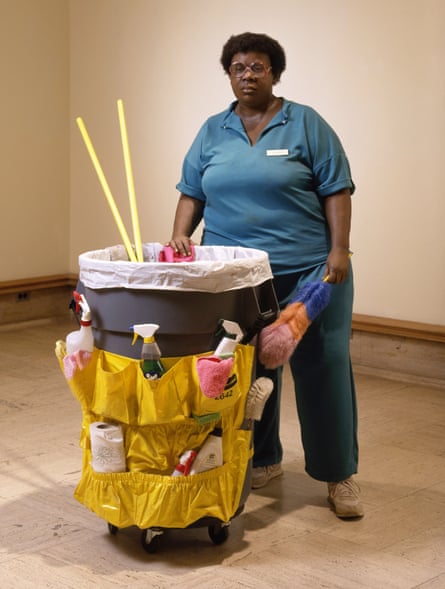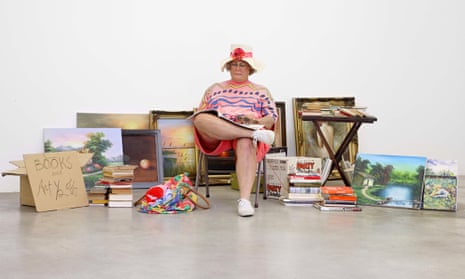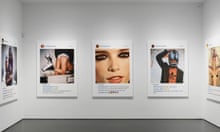There are some creators who died too early, who never lived to see their work get the attention it deserved. Van Gogh comes to mind, as does F Scott Fitzgerald – and Duane Hanson. Hanson created hyperrealist figurative work at a time when it was academically anathema. His sculptures were enormously popular with the public and this also made him critically suspect, a fact of which he was well aware. To be underrated because of transient political fashions left Hanson without a full sense of artistic community, and this feeling of isolation is in evidence in his work, particularly in the solo figures created in the last two decades before his death in 1996. Their loneliness is almost achingly beautiful, and is reminiscent of a fellow American unique, Edward Hopper.
I remember, in my early 20s, seeing Hanson’s work for the first time: the 1970 sculpture Tourists. I remember my realist wow moment, a moment most people experience on encountering his work. And I remember wondering: how does he do it? Technical prowess is something I always appreciate in artwork, but some people read prowess as entertainment. I never got that from his pieces. Hanson, born in Minnesota in 1925, created his realism because there was no other way for him to convey the relationship he saw between individuals and the societies they inhabit. His realism wasn’t Madame Tussauds, and it wasn’t mannequins in the store windows at Macy’s. So what was it?
It was only later in life that I realised Hanson was going for “realness”, a term used by drag queens in competitions when portraying archetypes: rich white women dressed for lunch; high-school football-players getting their photos taken for the yearbook. The word archetype is important here because Hanson was often dismissed as someone who worked in stereotypes – a word that is ontologically similar but wrong. Stereotypes are exaggerated characteristics temporarily tainted with conscious or subconscious contempt. Archetypes depict universal modes of being that reconfigure themselves over and over again across time, geography and culture.

Right now, we have a bit of distance between us and the 1970s, the era being almost half a century in the past. Hanson’s largely middle- and lower-middle-class figures convey the late 20th-century nothingness beneath the sheen of consumer culture; but, more importantly, as the middle-class now unravels, we’re learning that the shopping trolleys aren’t as full as they once were. We’re learning that to be a cartoon-like American tourist abroad is probably a bad idea that will most likely invite bad experiences. We’re also realising that, not far down the road, many museum-goers will share the same crappy jobs, or have no work at all, just like Hanson’s drifters.
It’s always fascinating to watch the public interact with Hanson’s work, to see that inevitable wow moment. It seems tailor-made for our times. In fact, could there be any work out there more selfie-friendly than Hanson’s? Technology has inverted some of the rules of appreciating art. What was once forbidden in the museum (the photo) is now encouraged. The eyeballs of Hanson’s figures no longer look out into space, but at the viewer’s camera, along with the viewer. What was once a power imbalance – the institution and the viewer – instead becomes intimate, curious, democratic and highly engaged. A new museum archive category seems to be emerging: a continuum of “selfieness”. At one end of the selfie spectrum is, say, the work of Donald Judd. It’s hard to imagine taking a selfie with one of his minimalist wall pieces. And at the other end of the selfie continuum, we have Hanson and, say, Jeff Koons. Selfieness is no indication of a work’s depth or anything else except, well, its selfieness. But whatever selfieness is, it’s possibly what institutions are looking for to help them navigate through the next 20 years. So maybe it’s not so odd a category after all.
The young and the old arrive at Hanson’s work differently. Younger people never saw Hanson’s real-life human subjects back in the day, so view his sculptures as historical: can you believe people really dressed like that and did all that crazy stuff? And then there are older art-world habitués, who probably remember the unspoken ideological fatwa on Hanson and who, maybe if they’re honest, helped perpetuate it; and now these people are old and falling apart, and here is Hanson’s work, eternal and as fresh as ever. Young people find it impossible to believe that someone whose work was so intense and so true could ever have been perceived as an outsider. Time always tells.
Hanson’s work is now only viewed in museums – and watching viewers interact with his forms is just as much a part of experiencing his work as admiring it on its own. It’s very different from seeing mannequins at the mall or model displays in anthropology museums. Hanson’s pieces are right there, equal with you. In some ways, they even feel more authentic than you: they come from an era where authenticity was the default mode of being, an era when reality reigned, and where a word like “realness” was still only something in an artist’s or a drag queen’s magic bag of tricks.



Comments (…)
Sign in or create your Guardian account to join the discussion